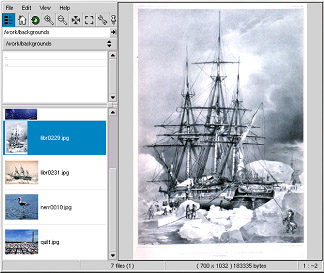Viewing Images
|
This section discusses some of the common tools for viewing image files. Certain tools available are specialized applications with several functions that enhance your image viewing experience, while others are general-purpose browsers that have some image viewing functionality.
Viewing Images with Nautilus
Nautilus is a general-purpose file manager and browser for your desktop environment. Nautilus has many functions beyond simple image viewing; however, for this section, we will focus on showing you how to use it for basic image browsing. For more information about Nautilus, see chapters 6 and 13.
Nautilus is known for its ease-of-use, and it handles images with the same ease as it does for other file types. To begin browsing your image collection with Nautilus, double-click on your home desktop icon.
You will be presented with a view of all the files and folders within your home directory. Double-click an image (or folder containing the image), and Nautilus will open the new file or folder within its browser window. Figure 15-1 shows that Nautilus automatically creates thumbnails of any images in your folders.

Figure 15-1. Contents of a Folder in Nautilus
Double-click on any thumbnail icon to view the image in its native size. The image will load within the browser window, along with a thumbnail view and detailed file information along the left panel.
Below the file information are advanced options for working with the file. By default, Nautilus offers you the option of opening the file with Eye of Gnome, a robust image viewer with more advanced imaging features than Nautilus.
To increase and decrease the size of the viewed image in Nautilus, click on the magnifying glass icon on the location bar.
![]()
Figure 15-2. The Zoom Function in Nautilus
Click the plus (+) icon to increase the size of the image or minus (-) to decrease it.
Viewing Images with GQview
GQview is a powerful image viewer for GNOME desktop users that supports several image file formats, including the following:
-
JPG/JPEG
-
GIF
-
PGM
-
XPM
-
PNG
-
PCX
-
TIF/TIFF
-
PPM
-
BMP
GQview is useful for viewing individual image files as well as browsing collections of files in folders. It supports zoom in and zoom out functions, as well as thumbnail views of all image files within a directory. It also supports several advanced options not found in the simple image viewers such as Nautilus and Konquerer.
GQview can be started from your desktop by clicking the Main Menu button and choosing Graphics > GQview (to start GQview from a shell or terminal prompt, type gqview).
Upon start-up, GQview will browse your user home directory by default. If you have any images in this directory, the gallery panel will automatically generate thumbnails for you to highlight and view in the main display area.

Figure 15-3. GQview Displaying a .jpg Image
The interface of GQview is straightforward. The toolbar allows you to fit the image to the display window, zoom in and out, and toggle between thumbnail view and text-only browser panels. It also has a text field for you to enter a particular path to your image directories. Right-clicking on an image in the display area opens a pop-up menu of image size and other file options such as renaming, moving, copying. You can also hide and unhide the thumbnail file panel and toggle window and full-screen modes within the pop-up menu.
You can also combine functions within GQview and create a dynamic presentation effect for groups of images within a directory. In the text field below the toolbar, type the path to the directory where your images are located and highlight the first image in the thumbnail file list panel on the left. Now press v then s, and you will start a full-screen slideshow where GQview displays images against a black background over your entire desktop. By default, each image in the slideshow is presented for 15 seconds. You can stop and resume the slideshow at any time by pressing s. When the slideshow ends, press v to exit full-screen mode.
GQview can also be used to change your desktop wallpaper quickly and easily. Right-click on the image and choose Edit > Set as wallpaper. From the Edit menu, you can also choose to open the file with a number of image editing utilities, including The GIMP, Xview, and Xpaint.
GQview also allows you to customize several settings by clicking the Configure button. The configuration pop-up menu allows advanced users to configure several options. You can customize a directory on startup, change thumbnail sizes, and even change the default image editors to manipulate the file if you would like to use one that is not listed.

Figure 15-4. The GQview Options Dialog Box
|
EAN: N/A
Pages: 223